Ventilation anemostat: design specifics + review of TOP brands on the market
One of the conditions for a comfortable microclimate in the house is sufficient air circulation.When arranging the climate system of a room, it is advisable to provide the ability to smoothly adjust the intensity of air jets.
Anemostats cope with this task. Before choosing an air distributor, you should understand what a ventilation anemostat is and how to choose a model based on specific operating conditions.
The identified issues have been studied by us and presented in detail in the article. In addition to recommendations for selection, we have prepared a review of popular brands and popular modifications of ventilation anemostats.
The content of the article:
Using an anemostat in a ventilation system
An anemostat is the final element of the ventilation system, responsible for the uniform distribution of air masses in a closed room. Essentially, this is an alternative version of a diffuser or the usual ventilation grille.
The device is actively used in air heating systems, air conditioning and ventilation, both domestic premises and industrial buildings.
The main task of the anemostat is the formation and distribution of air flow entering the room from the outside or vice versa, directed into the exhaust pipe.

“Plafond” is responsible for a number of additional, but no less important functions:
- adjusting the volume of supplied air;
- elimination of drafts - the device provides aero-convection, thereby eliminating the likelihood of air turbulence;
- effective ventilation of the room - fresh air streams fill the entire interior space of the room;
- blocking the air duct opening.
Some models of air distributors are equipped with a filtration element that retains dust particles from incoming street air.

Typical device and principle of operation
The design of the anemostat is extremely simple.
Standard equipment includes:
- round body;
- fastening coupling;
- flanged adjustable baffles;
- disk with threaded rod.
A spacer with an adjusting screw and a movable plate is inserted inside the ventilation duct.

When moving the cover counterclockwise, the passage gap increases, and accordingly, the air inflow or outlet increases. The cross-country ability of the device increases when the lampshade is turned clockwise.
Some anemostats have two plates: one is concave with a larger diameter, the second is of a standard shape. This modification distributes air better.
Design and functional features
Depending on the nature of the distribution and direction of air jets, three types of anemostats are distinguished: supply, exhaust and universal.
The supply type air distributor is equipped with a shield concave inward. The shape of the plate has minimal aerodynamic resistance, due to which the air masses are distributed evenly. Such an anemostat is installed in air ducts supply ventilation.

In the exhaust air vent, the outer cover has a rounded, smooth shape to effectively remove exhaust air.
The universal supply and exhaust anemostat is equipped with two dividing hoods.
The nuances of using the combined model:
- when installing in an exhaust system, it is permissible to use two slots formed by plates at the same time;
- working in the supply ventilation system involves opening one gap created by a concave shield; In this case, the exhaust hole must be closed.
The selection of the appropriate mode is carried out manually - a technological gap of the required size is installed.
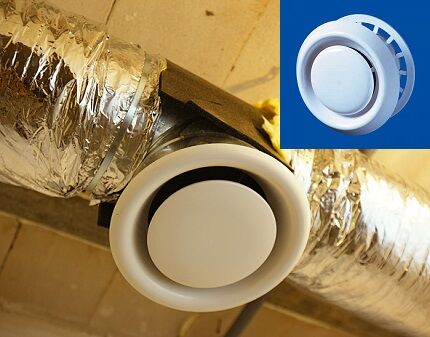
Anemostat and diffuser: similarities and differences
Despite the fact that both devices perform similar tasks, the operating principle of the air distributors is different. The diffuser itself is not designed to regulate the flow rate.
The angle of inclination of the lamellas of the supply and exhaust diffuser is fixed, and to adjust the volume of air flow, various modifications of manually controlled dampers are provided.
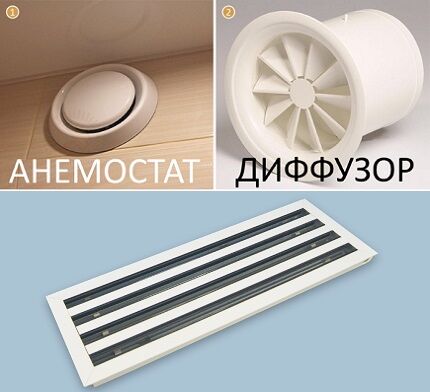
Criteria for selecting an air distributor
Determining the optimal model of an anemostat should be based on an assessment of a number of parameters: material of manufacture, dimensions of the device, operating range of the plate and area of the slot opening. All criteria are selected taking into account operating conditions.
Material of manufacture: which is more practical and durable
Light materials are used in production: aluminum, plastic or galvanized steel. Exclusive options are made of wood. Each product has its pros and cons.
Metal. The peculiarity of metal products is wear resistance and service life.An additional advantage is a beautiful external design that goes well with different style trends in the interior.
Disadvantages include: high cost and complicated installation due to heavy weight.
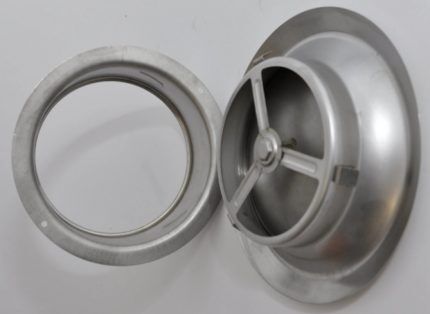
Stainless steel products are installed in baths, saunas or combustion chambers.
Plastic. Plastic anemostats are usually used in everyday life, commercial, office and public buildings. The products have proven themselves well in wet areas (shower room, laundry room, kitchen, swimming pool, bathroom).
Competitive advantages of polymer anemostats:
- resistance to moisture - do not corrode like metal and do not rot like wood;
- light weight and easy installation;
- variety of sizes and colors;
- unpretentiousness in care and maintenance;
- low cost.
Negative aspects of plastic: low strength and inability to use for “pumping” hot air masses.
Tree. Such specimens are quite rare; they are mainly used if the design of the room requires it. Anemostats look organically in the interior of a wooden house, bathhouse or sauna.
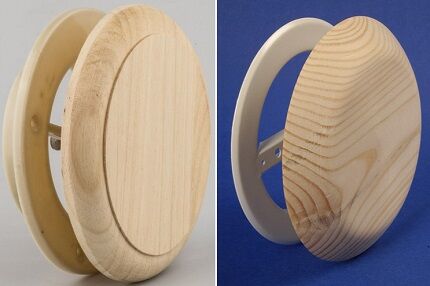
Evaluation of the technical characteristics of the anemostat
After selecting the type of distributor (exhaust or supply), assessing the operating conditions and determining the appropriate material, you should select a model based on three parameters: diameter, slot size and valve stroke.
Diameter. The cross-section of the anemostat head must be compared with the size ventilation system channel. For example, a corresponding 100 mm distributor will fit under a 100 mm air duct.

Slot hole. The parameter determines the device bandwidth. The run-up of indicators is the adjustment of the gap using a flange. In small models with a diameter of 80 mm, the limiting area of the live section is 0.002 sq.m; in anemostats with a size of 200 mm, the figure reaches 0.009 sq.m.
Power reserve. The indicator characterizes the maximum opening - the movement of the “plafond” along the normal. The greater the valve stroke, the wider the range of operation of the anemostat. The limit value in different models reaches 8-30 mm.
Type of ventilation "shade" control
Most models are designed for mechanical adjustment of the plate position. The operating mode of the air distribution valve is set manually - just turn the “plafond” clockwise or vice versa.
In this case, the ease of control depends on the location of the anemostat. When mounted on a ceiling, it is difficult to change the position of the plate. To simplify the task, it is better to choose an automatic device with a control unit.

Review of popular brands and modifications
Anemostats are represented on the ventilation systems market by various manufacturers. The sales leader is the product Vents. Air distributors compete with them Dospel, Blauberg, Lessar And Systemair. Let us consider the proposed modifications of popular manufacturers in more detail.
Vents – wide range of anemstats
The company sells six series of anemostats:
- A*VR – combined plastic;
- A*VRF – universal with a plastic flange;
- A*PR – inlet plastic;
- A*PRF – inlet with mounting flange, material of manufacture – plastic;
- AM*VRF – universal metal with flange;
- AM*VRF N – supply and exhaust made of stainless steel.
Combined anemostats A*VR and A*VRF are made of polystyrene or ABS plastic. Both models are suitable for wall or ceiling mounting.

The difference is that A*VRF anemostats are equipped with a flange and a restrictive ring, allowing you to quickly and easily fix the air distributor in the ventilation duct.
Models A200VR, A200VRF and A200/150VRF are equipped with two control elements - this ensures better redistribution of air masses.
Supply anemostats A*PR and A*PRF are available in two diameters: 150 mm, 200 mm.
Relevant characteristics of the air distributors:
- cross-sectional area – 0.011 and 0.012 sq.m;
- The maximum normal stroke of the plate is 21 and 22 mm.
The cost of Vents plastic air distributors without a flange is 4-9 USD, depending on the dimensions and the presence of a flange.
Metal models of combined anemostats (AM*VRF and AM*VRF N) are presented in four standard sizes: 100, 125, 150 and 200 mm.
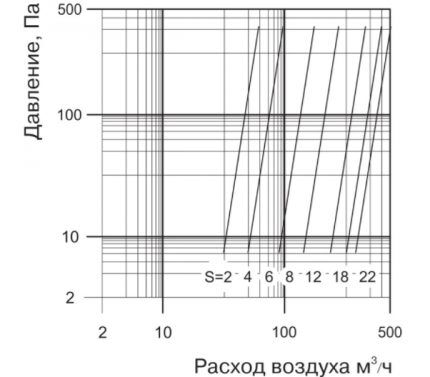
The price for steel products with a polymer layer is 9-12 USD, for stainless steel anemostats – 25-100 USD.
Dospel – air distributors made in Poland
Company Dospel (Poland) specializes in the manufacture of ventilation equipment and accessories.
Air distributors are presented in three subcategories:
- AN* — supply units made of plastic;
- ANM*EV – exhaust metal anemostats;
- ANM*SV – supply distributors made of metal.
AN series lampshades are available in diameters of 100, 125 and 150 mm. The maximum opening of the sash reaches 16, 13 and 21 mm.
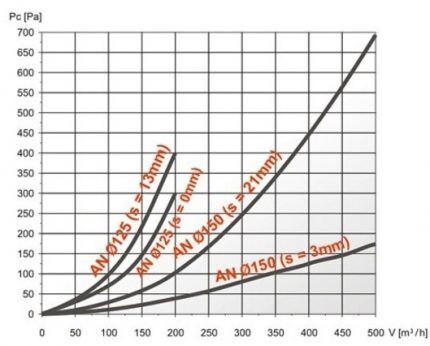
Dospen metal supply and exhaust distributors are made of stainless steel and powder coated. Both series (ANM*EV and ANM*SV) are available in five sizes: minimum – 100 mm, maximum – 250 mm.
The estimated cost of plastic models is 4 USD, metal ones – 6-19 USD.
Blauberg: VPR and VMR series models
German corporation Blauberg Ventilatoren offers two types of supply and exhaust air distributors:
- VPR – plastic with mounting flange. They are made from polymers that are resistant to UV rays and temperature influences; the plastic contains antistatic additives. Overall dimensions are suitable for air ducts of 80-200 mm. Maximum cross-sectional area – 0.009 sq.m.
- VMR – metal anemostats. The production material is steel, on top there is a layer of white polymers. The model range includes four positions from 100 to 200 mm.
The high strength characteristics of both models determine their wide range of applications: residential, utility, office, retail premises, kindergartens and medical institutions.

Exhaust and supply anemostats Lessar
Firm Lessar has production facilities in China and various European countries. The company's products are in demand due to their decent quality and affordable prices. Anemostats are produced in a limited range - metal devices of exhaust and supply type.
Distinctive features of Lessar air distributors:
- the lineup: LV-DCP – for supply ventilation systems, LV-DCV – for exhaust air ducts;
- channel cross-section: 100, 125, 160 and 200 mm;
- throughput anemostats – 10-500 cubic meters/hour;
- price – 5-10 USD (depending on the dimensions of the product).
Lessar anemostats are much cheaper compared to similar metal models from other manufacturers.

Systemair – European quality ventilation devices
Swedish brand Systemair sells a standardized line of ventilation equipment: fans, air handling units and air distributors.
Types of Systemair anemostats:
- Balance-E. Exhaust type device made of regenerated polypropylene. The material withstands high temperatures (up to +100°C) and chemical compounds in moderate concentrations. Four variations are designed for air ducts of 100, 125, 160 and 200 mm. The maximum air gap is 20 mm.
- Balance-S. Inlet anemostat, made of the same plastic as the previous model. Available in three sizes: 100, 125 and 160 mm.
- EFF. A universal steel distributor capable of operating in “exhaust” and “supply” modes of air. EFF modifications have a diameter from 63 to 200 mm, the stroke of the central cone is up to 28 mm.
- TFF. Supply anemostat made of steel. The design includes an inlet cone and a flat soundproofing disc. Available in diameters 80-200 mm.
Models Balance-E, Balance-S and EFF are installed using a mounting ring or directly into the duct. TFF is fixed in the ventilation duct with spacer springs or in the mounting frame.
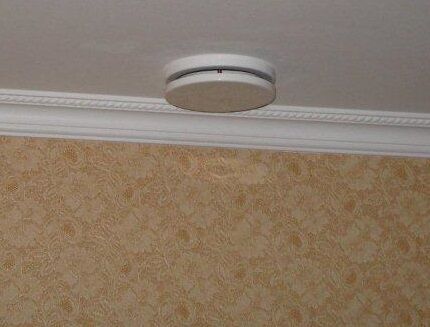
Conclusions and useful video on the topic
Typical device of a universal adjustable “diffuser”:
Operation of the automatic anemostat:
Technology for installing an air distributor in a plasterboard box:
Anemostat is a simple and effective solution for improving the microclimate. The device is responsible for a uniform flow of fresh air in the plenum ventilation system and regulates the release of “exhaust” in the exhaust ducts. An important advantage of the air distributor is its affordable price.
Are you looking for an effective ventilation anemostat? Or do you have experience using such installations? Please leave comments on the article, participate in discussions and share your impressions about using anemostats.




Interesting article, but could you also add designer glass diffusers to it? http://www.Airg-rus.ru